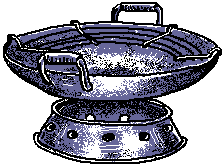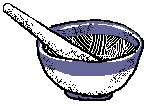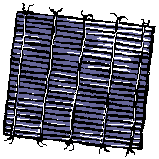|
|
|
A
wok is a wonderful cooking utensil for the Japanese
kitchen. Wok's are bowl shaped, rolled steel pans that are perfect
for stir frying, steaming, deep frying, and simmering foods. The
high sides of the wok make stir frying easy without flipping ingredients
out of the pan, and it takes very little oil to fry foods since
there is less surface space to cover in a wok. Most woks come
with a cooking spatula, ladle, cover, stand, and a rack (see picture),
where you can place fried foods to drain.
|
 |
|
|
Whether
you're
cooking soba (buckwheat),
or udon (white flour) noodles...
you'll want a deep pot and a colander (a large plastic strainer
being the best). Fill the pot half way with water and bring to
a rolling boil. Be sure to place the noodles in the pot only when
the water is extremely hot. Stir occasionally to make sure the
noodles don't stick to each other (you can add a little bit of
cold water to the pot when it threatens to boil over).
Be
sure not to over cook the noodles... they should never be soft
and soggy but firm. Have the hot water running in your sink and
place the colander in the basin... pour the pot of boiling noodles
into the colander and allow hot water to run over the strainer
full of noodles until the water runs clear. This is the most crucial
part of making good noodles, if improperly washed the noodles
will be starchy and sticky. Allow the noodles to drain and then
serve in hot broth or with hot dipping sauce.
To
make noodles that you will serve cold (a real treat in hot weather),
rinse your noodles in cold water until the water runs clear, then
place in ice water for a few minutes, rinse again, drain and serve
with cold dipping sauce.
|
 |
This
ingenious device consists of a clear plastic bucket and a spring
loaded screw top lid. You place your salted vegetables in the
bucket, put on the lid, and then screw the spring loaded "handle"
down until the inner lid is placing pressure upon the food. I
highly recommend getting one of these if you want to make Japanese
pickles on a regular basis.
|
|
|
The
simplest Japanese meal consists of a bowl of rice and a pickled
plum. Boiled rice is the staple, the backbone of the Japanese
diet, so knowing how to make it properly is necessary. When
cooking rice for a Japanese meal never use the long grained
rice common to Westerners, you must use only the short grained
Japanese rice. Japanese rice has a soft sticky texture when
cooked, making it perfect for sushi, onigiri
(rice balls), and other quintessential Japanese dishes. To cook
rice do the following...
Place
one cup of rice in a deep bowl or pot and add about a quart of
water. Stir gently with your hand and pour off the cloudy, white
water. Add more water and stir vigorously, pour off the cloudy
water. Repeat this process until the water is clear. Now place
the rice in a colander and allow it twenty minutes to drain and
expand. Place the rice in a cooking pot with two cups of water,
bring to a boil, cover, turn down the heat to very low and in
twenty minutes your rice will be done.
Most
modern Japanese cooks use an electric, automatic rice cooker,
and after you start using one you'll begin to wonder how you lived
without it. Simply place into your rice cooker a cup of rice and
two cups of water, turn the rice cooker on... and some twenty
minutes later you have perfect rice! A great utensil for busy
people or students.
|
|
This
traditional ceramic grinding bowl has a serrated inner surface
and is used to make sesame paste. Toasted white sesame seeds are
placed into the suribachi along with sugar and then
ground into a paste. Suribachi can also be used to grind other
foods. The bowl usually comes with a wooden pestle.
|
 |
|
|
|
Dashi
is a stock made from konbu (kelp) and katsuo-bushi
(dried bonito fish). Along with shoyu (soy sauce),
dashi is used most frequently in Japanese cooking in everything
from soups to simmered vegetable dishes. Dashi is the foundation
for innumerable dishes.
Place
two quarts of cold water in a large deep pot. Take about 20 inches
of konbu/kelp (about 1 1/2 oz.), and carefully and thoroughly
wipe the konbu with a clean moistened cloth (do not wash kombu
as it removes the flavor). Place the konbu into the pot and slowly
bring the water to just before the boiling point, regulate the
heat so that the water never actually boils. By simmering the
konbu in this way you are releasing it's flavor and once the kelp
is tender (about fifteen minutes),
remove the seaweed.
Add
3 cups of loose bonito flakes and turn off the heat. Once the
flakes have sunk to the bottom of the pot (about a minute or two),
strain the stock into another pot or receptacle using a colander
filled with cheesecloth or a large coffee filter. The finished
dashi should be a light golden color and free of any bonito flake
particles. You can store dashi in the refrigerator for up to three
days but it's best to use as soon
as it's made.
|
 |
This
implement is called a sushimaki sudare and is used
to make sushi rolls. The sudare is made of thin slats of bamboo
tied together in order to make a flexible mat about the size of
a standard sheet of writing paper (about ten inches square). You
can also use the sudare to squeeze out the excess water from steamed
spinach, cabbage, and
other vegetables.
|
|
|
Sake
is not just the traditional drink of Japan, it is an essential
cooking ingredient! Sake
is used in everything from soup stock to dipping sauces so you
should have a bottle of it in your kitchen. Mirin is a sweet
sake especially for use in cooking. A small bottle of
mirin should also have a place on your kitchen shelf.
|
|
|
Shoyu
is the foundation of Japanese cooking, it is the essential ingredient.
Shoyu is not only used as a condiment to flavor foods but it's
also used to cook with.
There are many types of shoyu available and I highly suggest stocking
your kitchen with a variety of them. Shoyu is made by fermenting
a mixture of soybeans, wheat, salt and water. Once a bottle of
shoyu is opened it starts to loose it's flavor so it's best to
keep it refrigerated.
|
|
|
|
A
good set of sharp knives is the best ally of any serious cook.
The Japanese make an excellent knife called the hocho,
which makes cutting vegetables a real joy. Invest in some good
knives if you want to spend time in the kitchen.
|
 |
Donabe
are eathenware pots used in the cooking of stews and simmered
dishes. A donabe pot is glazed on the inside and left unglazed
on the outside bottom, it is heat resistant and meant to be placed
directly on the burner. Donabe come in various sizes from small
to large, the small pots can be used to cook a humble meal for
one but a large pot is required to cook a family sized dinner.
|
|